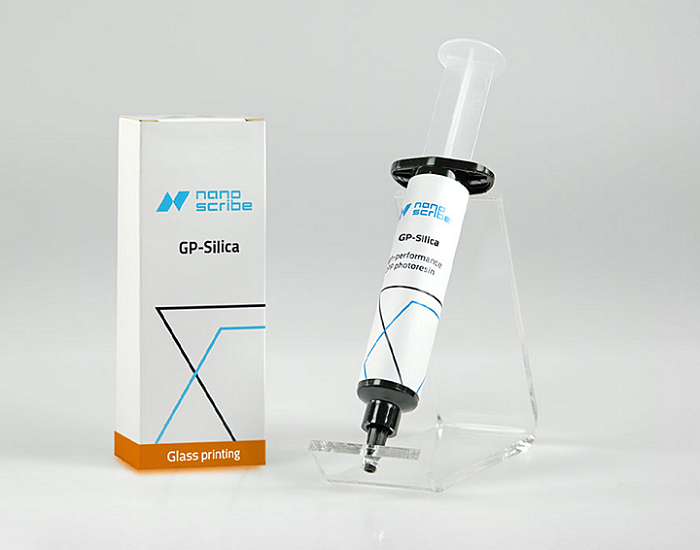German additive manufacturing company Nanoscribe, a spinoff of the Karlsruhe Institute of Technology (KIT) and a recent part of the CELLINK Group, specializes in maskless lithography systems for microfabrication, in addition to novel 3D printing materials like photoresins. The company just recently launched a new Glass Printing Explorer Set, which it describes as the “first commercially available high-precision” AM material and process for 3D microprinting fused silica glass (FSG) microstructures.

Nanoscribe offers the world’s first photoresin GP-Silica for 3D Microfabrication of glass microstructures.
In its new set, Nanoscribe offers GP-Silica, the first FSG for 3D microfabrication, which it developed as part of a joint research project with Glassomer GmbH, a room temperature shaping glass specialist. The material has high optical transparency, along with great chemical, mechanical, and thermal properties. With all of these combined, GP-Silica sounds like it will be a good choice for new applications in material engineering, microfluidics and microoptics, life sciences, and other fields in microtechnology.
This new resin is a composite of silica nanoparticles, dispersed in a photo curable binder matrix, that was optimized for and can be 3D printed directly with Nanoscribe’s microfabrication systems, such as its Photonic Professional GT2. Two-photon polymerization, or 2PP, of this new FSG material is a great new tool for researchers due to its excellent properties.

Nanoscribe calls its Photonic Professional GT2 “the world’s highest resolution 3D printer.” The field-proven solution is engineered as an open system, suitable for a wide range of scales, designs, and applications. Thus, it is an ideal instrument for scientific microfabrication and prototyping in multi-user facilities and research laboratories.
Dr. Nicolas Muller, Assistant Professor and Head of Graphical Printing at the School of Engineering and Architecture of Fribourg in Switzerland, stated that, “GP-Silica has great potential for our research manufacturing complex microfluidics systems, although the required thermal post-processing is demanding.”
Glass is a new class of materials for 3D microprinting, and Nanoscribe’s new GP-Silica has all the best features of regular silica glass, which makes it possible to print glass microstructures with smooth, optical-quality surfaces. It’s also good for imaging applications, thanks to an optical transmission window that goes from the UV right to the infrared region.

The fabrication process starts with the 2PP-based high-precision 3D printing of a microstructure. The resulting green part consists of silica nanoparticles homogeneously suspended in a polymer binder matrix. In a two-step thermal process, the polymer is first removed from the printed microstructure. Then, the silica nanoparticles fuse in a second step to form the final microstructure of pure fused silica glass.
When you’re combining glass processing with 3D printing, you need to factor in thermal treatments; as such, a two-step fabrication process for GP-Silica is necessary. First, you print highly precise microstructures from the resin. Any unpolymerized material is then washed away, which leaves you with a “green” part, made up of silica nanoparticles suspended homogeneously in a polymer binder matrix. Then, the two-stage thermal process begins, first removing the polymer from the 3D printed microstructure at 600°C, followed by a sintering process at 1,300°C to fuse the silica nanoparticles. The part shrinks in volume as this happens, forming the final pure fused silica glass microstructures.

The green part of a 3D printed filter tube (left) and corresponding filter tube after the sintering process (right). Glass microstructures are suitable for sterilization and typically biocompatible, making the printing material GP-Silica a good choice for life science applications.
As Nanoscribe states, the new Glass Printing Explorer Set is “the optimal starting point for the high-precision additive manufacturing of glass microstructures that feature material properties that are identical to that of other commercially available fused silica.”
(Source/Images: Nanoscribe)
Subscribe to Our Email Newsletter
Stay up-to-date on all the latest news from the 3D printing industry and receive information and offers from third party vendors.
You May Also Like
Printing Money Episode 17: Recent 3D Printing Deals, with Alex Kingsbury
Printing Money is back with Episode 17! Our host, NewCap Partners‘ Danny Piper, is joined by Alex Kingsbury for this episode, so you can prepare yourself for smart coverage laced...
Insights from Cantor Fitzgerald on AM’s Q1 2024 Landscape
A recent survey by Cantor Fitzgerald sheds light on the persistent challenges within the additive manufacturing (AM) industry in the first quarter of 2024. Based on responses from 38 industry...
3D Printing Financials: Xometry’s Scaling up and Strong Start to 2024
Xometry (Nasdaq: XMTR) kicked off 2024 with strong results, boosting its marketplace and technology to new heights. Both revenue and gross margin soared, fueled by an expanding global network of...
3D Printing Financials: Desktop Metal Targets Recovery Amid Net Losses and Revenue Downturn
Despite facing a decline in revenue and the persistent challenges of a tight economic climate, Desktop Metal (NYSE: DM) is making strides toward operational efficiency. The first quarter of 2024...
































